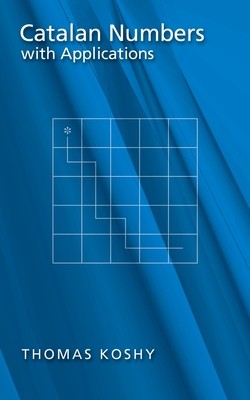
- We will send in 10–14 business days.
- Author: Thomas Koshy
- Publisher: Oxford University Press, USA
- ISBN-10: 019533454X
- ISBN-13: 9780195334548
- Format: 16.3 x 23.9 x 2.8 cm, hardcover
- Language: English
- SAVE -10% with code: EXTRA
Reviews
Description
Like the intriguing Fibonacci and Lucas numbers, Catalan numbers are also ubiquitous. "They have the same delightful propensity for popping up unexpectedly, particularly in combinatorial problems," Martin Gardner wrote in Scientific American. "Indeed, the Catalan sequence is probably the most frequently encountered sequence that is still obscure enough to cause mathematicians lacking access to Sloane's Handbook of Integer Sequences to expend inordinate amounts of energy re-discovering formulas that were worked out long ago," he continued.
As Gardner noted, many mathematicians may know the abc's of Catalan sequence, but not many are familiar with the myriad of their unexpected occurrences, applications, and properties; they crop up in chess boards, computer programming, and even train tracks. This book presents a clear and comprehensive introduction to one of the truly fascinating topics in mathematics. Catalan numbers are named after the Belgian mathematician Eugene Charles Catalan (1814-1894), who "discovered" them in 1838, though he was not the first person to discover them. The great Swiss mathematician Leonhard Euler (1707-1763) "discovered" them around 1756, but even before then and though his work was not known to the outside world, Chinese mathematician Antu Ming (1692?-1763) first discovered Catalan numbers about 1730. Catalan numbers can be used by teachers and professors to generate excitement among students for exploration and intellectual curiosity and to sharpen a variety of mathematical skills and tools, such as pattern recognition, conjecturing, proof-techniques, and problem-solving techniques. This book is not only intended for mathematicians but for a much larger audience, including high school students, math and science teachers, computer scientists, and those amateurs with a modicum of mathematical curiosity. An invaluable resource book, it contains an intriguing array of applications to computer science, abstract algebra, combinatorics, geometry, graph theory, chess, and World Series.EXTRA 10 % discount with code: EXTRA
The promotion ends in 18d.15:55:45
The discount code is valid when purchasing from 10 €. Discounts do not stack.
- Author: Thomas Koshy
- Publisher: Oxford University Press, USA
- ISBN-10: 019533454X
- ISBN-13: 9780195334548
- Format: 16.3 x 23.9 x 2.8 cm, hardcover
- Language: English English
Like the intriguing Fibonacci and Lucas numbers, Catalan numbers are also ubiquitous. "They have the same delightful propensity for popping up unexpectedly, particularly in combinatorial problems," Martin Gardner wrote in Scientific American. "Indeed, the Catalan sequence is probably the most frequently encountered sequence that is still obscure enough to cause mathematicians lacking access to Sloane's Handbook of Integer Sequences to expend inordinate amounts of energy re-discovering formulas that were worked out long ago," he continued.
As Gardner noted, many mathematicians may know the abc's of Catalan sequence, but not many are familiar with the myriad of their unexpected occurrences, applications, and properties; they crop up in chess boards, computer programming, and even train tracks. This book presents a clear and comprehensive introduction to one of the truly fascinating topics in mathematics. Catalan numbers are named after the Belgian mathematician Eugene Charles Catalan (1814-1894), who "discovered" them in 1838, though he was not the first person to discover them. The great Swiss mathematician Leonhard Euler (1707-1763) "discovered" them around 1756, but even before then and though his work was not known to the outside world, Chinese mathematician Antu Ming (1692?-1763) first discovered Catalan numbers about 1730. Catalan numbers can be used by teachers and professors to generate excitement among students for exploration and intellectual curiosity and to sharpen a variety of mathematical skills and tools, such as pattern recognition, conjecturing, proof-techniques, and problem-solving techniques. This book is not only intended for mathematicians but for a much larger audience, including high school students, math and science teachers, computer scientists, and those amateurs with a modicum of mathematical curiosity. An invaluable resource book, it contains an intriguing array of applications to computer science, abstract algebra, combinatorics, geometry, graph theory, chess, and World Series.

Reviews